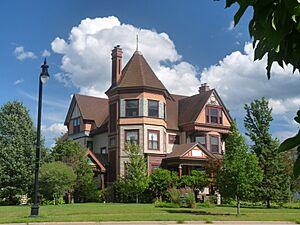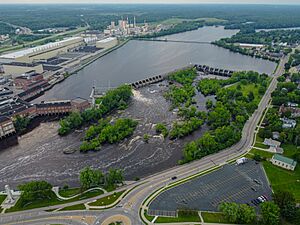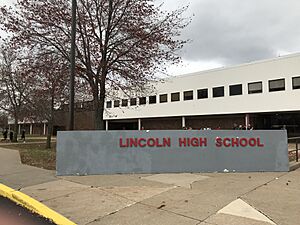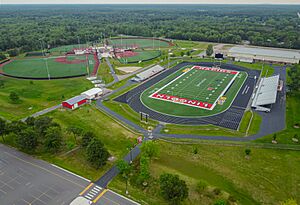Wisconsin Rapids, Wisconsin facts for kids
Quick facts for kids
Wisconsin Rapids, Wisconsin
|
|
|---|---|

Wood County Courthouse
|
|
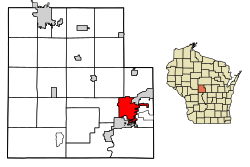
Location of Wisconsin Rapids, Wisconsin
|
|
| Country | United States |
| State | Wisconsin |
| County | Wood |
| Founded | 1900 |
| Incorporated | April 6, 1868 |
| Area | |
| • City | 14.795 sq mi (38.319 km2) |
| • Land | 13.902 sq mi (36.005 km2) |
| • Water | 0.893 sq mi (2.314 km2) |
| Elevation | 1,027 ft (313 m) |
| Population
(2020)
|
|
| • City | 18,877 |
| • Estimate
(2023)
|
18,670 |
| • Density | 1,343.69/sq mi (518.81/km2) |
| • Urban | 29,550 |
| • Metro | 73,939 |
| Time zone | UTC–6 (Central (CST)) |
| • Summer (DST) | UTC–5 (CDT) |
| ZIP Codes |
54494, 54495
|
| Area code(s) | 715 and 534 |
| FIPS code | 55-88200 |
| GNIS feature ID | 1576906 |
Wisconsin Rapids is a city in Wood County, Wisconsin, United States. It is the county seat, which means it's where the county's government is located. The city is built along the Wisconsin River. In 2020, about 18,877 people lived here. Wisconsin Rapids is a main city in the Marshfield–Wisconsin Rapids area. This area includes all of Wood County.
The city started in the late 1830s. The Wisconsin River had many fast-moving parts called rapids. These rapids were perfect for powering sawmills. Nearby forests had lots of pine trees that could be cut down and floated on the river. Later, when there were fewer trees, the water power was used to make electricity and run other businesses, especially paper mills.
Contents
History of Wisconsin Rapids
Early Days and Sawmills
Before Europeans settled here, the Menominee people lived near the big rapids. They called the place "Ah-dah-wah-gam," meaning "Two-sided Rapids." This was because a large rock split the rapids into two parts. In 1836, the Menominee gave this land to the U.S. government.
In 1832, a man named Daniel Whitney built a sawmill downstream. This showed that it was possible to float lumber down the river to sell. After the land became available in 1836, many lumbermen came to find places for mills. By 1839, two sawmills were already working at what would become Wisconsin Rapids.
The first house in Rapids was a small log cabin. Soon after, Nelson Strong built the first frame house in 1838. The first church services were held by Catholic priests in 1837. A Methodist missionary started a primary school in a log cabin in the early 1840s. The first hotel opened in 1843, and a post office called Grand Rapids started in 1845.
In 1846, a pioneer named J.L. Cotey described the town. He said there were about 130 men and 17 women. There were businesses, homes, and sawmills. Logs were cut in the winter and floated down the river in spring floods. These logs were caught in special areas called booms at the sawmills. The sawmills cut the logs into boards. Most of these boards were sent to distant markets like St. Louis.
The boards were tied together into large rafts. These rafts were called "cribs." Six or seven cribs made a "rapids piece," a 100-foot-long raft that could handle the dangerous rapids. Grand Rapids was one of the most dangerous spots. Later, dams were built across the river to create chutes for the rafts. People would watch the rafts go down these chutes.
Growth and New Industries
In 1848, more land in northern Wisconsin became open to loggers. In 1856, Grand Rapids became the county seat of the new Wood County. By 1857, Grand Rapids had about 1,000 people. There were many sawmills, producing millions of board feet of lumber each year. The town had 187 buildings, including homes, churches, schools, and stores. The first newspaper, the Wood County Reporter, started in 1857.
Growth slowed during the American Civil War. A big flood in 1864 and a fire in 1865 also caused problems. In 1869, Grand Rapids officially became a city.
Centralia, another community on the west side of the river, also grew. It had sawmills and other businesses. In the 1850s, a ferry carried people across the river between Centralia and Grand Rapids. A wooden bridge was built in the 1860s. In 1874, Centralia became a city too.
Railroads and Paper Mills
Railroads arrived in the 1870s. The Green Bay and Lake Pepin Railroad reached Rapids in 1872. The Wisconsin Valley Railway arrived in 1873. These railroads changed how lumber was transported. It became easier and safer to move lumber by train instead of by river. The last lumber rafts floated through in 1888.
In 1880, a big flood caused many businesses to move their goods to higher ground. Some buildings were swept away. By this time, pine trees were running out near Grand Rapids. New types of factories started in Centralia, like machine shops and a chair factory. In 1887, the first pulp mill was built. This was the start of the paper industry.
Paper-making became a very important industry for Rapids. Around 1885, some old sawmills started making pulp and paper. By 1902, many mills and water rights were brought together under one company, Consolidated Water Power Company. This company focused on making paper.
Other businesses also started, moving away from just lumber. These included brick companies, foundries, and furniture companies. Farmers also settled in the surrounding areas, leading to businesses like canning and creameries.
Modern public services began to appear around 1900. Fire departments were created. The T.B. Scott Library opened in 1889. Electricity came to Rapids in the 1890s. A telephone company started in 1895.
20th Century and Today
In 1900, the cities of Grand Rapids and Centralia joined together. The new city was called Grand Rapids. In 1920, the name was changed to Wisconsin Rapids. This was done because mail often got sent to Grand Rapids, Michigan by mistake.
A small hospital opened in 1904. Parks were developed along the river. In 1909, a streetcar line was built, connecting Rapids to nearby towns. A public swimming pool was built in 1913 to help prevent drownings in the river.
The city added an airport in 1928. During the Great Depression, Consolidated Papers helped its workers by reducing work hours instead of laying people off. They also started making coated papers more efficiently, which were used for magazines like Life Magazine.
During World War II, many people from Wisconsin Rapids joined the military. At home, people grew victory gardens and collected scrap metal to help the war effort. Factories also made things for the army.
In the 1970s, many small corner stores were replaced by supermarkets. The Rapids Mall was built. A new highway, the Riverview Expressway, was also constructed.
In the 1980s, Consolidated Papers was a very successful company. It was the largest producer of special paper for magazines in the world. However, as people started using computers and TVs more, the need for paper dropped. In 2020, the paper mill in Rapids closed. Today, big employers include Riverview Hospital and Renaissance Learning, an educational software company.
Geography
Wisconsin Rapids is located at 44.3835763 degrees North and 89.8173466 degrees West.
The city covers about 14.795 square miles (38.319 square kilometers). Most of this area, about 13.902 square miles (36.005 square kilometers), is land. The rest, about 0.893 square miles (2.314 square kilometers), is water.
People in Wisconsin Rapids
The population of Wisconsin Rapids has grown over the years.
| Historical population | |||
|---|---|---|---|
| Census | Pop. | %± | |
| 1870 | 1,115 | — | |
| 1880 | 1,350 | 21.1% | |
| 1890 | 1,702 | 26.1% | |
| 1900 | 4,493 | 164.0% | |
| 1910 | 6,521 | 45.1% | |
| 1920 | 7,243 | 11.1% | |
| 1930 | 8,726 | 20.5% | |
| 1940 | 11,416 | 30.8% | |
| 1950 | 13,496 | 18.2% | |
| 1960 | 15,042 | 11.5% | |
| 1970 | 18,587 | 23.6% | |
| 1980 | 17,995 | −3.2% | |
| 1990 | 18,245 | 1.4% | |
| 2000 | 18,435 | 1.0% | |
| 2010 | 18,367 | −0.4% | |
| 2020 | 18,877 | 2.8% | |
| 2023 (est.) | 18,670 | 1.6% | |
| U.S. Decennial Census 2020 Census |
|||
In 2022, there were about 8,527 households in Wisconsin Rapids. On average, there were about 2.15 people in each household. The average household income was $51,186. About 14.3% of the people in the city lived below the poverty line. About 63.2% of the population had jobs. Most adults, 91.4%, had a high school diploma. About 16.3% had a bachelor's degree or higher.
The main ethnic groups reported were English, Spanish, Indo-European, and Asian. The average age in the city was 38.3 years old.
2020 Census Details
In 2020, there were 18,877 people living in Wisconsin Rapids. There were 8,655 households. The city had about 1,360 people per square mile.
Here's a look at the different groups of people in Wisconsin Rapids:
| Race / ethnicity (NH = non-Hispanic) | Pop. 2000 | Pop. 2010 | Pop. 2020 | % 2000 | % 2010 | % 2020 |
|---|---|---|---|---|---|---|
| White alone (NH) | 17,195 | 16,646 | 16,184 | 93.27% | 90.63% | 85.73% |
| Black or African American alone (NH) | 63 | 132 | 235 | 0.34% | 0.72% | 1.24% |
| Native American or Alaska Native alone (NH) | 141 | 164 | 147 | 0.76% | 0.89% | 0.78% |
| Asian alone (NH) | 638 | 664 | 661 | 3.46% | 3.62% | 3.50% |
| Pacific Islander alone (NH) | 2 | 3 | 5 | 0.01% | 0.02% | 0.03% |
| Other race alone (NH) | 7 | 13 | 55 | 0.04% | 0.07% | 0.29% |
| Mixed race or multiracial (NH) | 147 | 210 | 723 | 0.80% | 1.14% | 3.83% |
| Hispanic or Latino (any race) | 242 | 535 | 867 | 1.31% | 2.91% | 4.59% |
| Total | 18,435 | 18,367 | 18,877 | 100.00% | 100.00% | 100.00% |
About 22.3% of residents were under 18 years old. About 19.7% were 65 or older. The city had slightly more females (54.7%) than males (45.3%).
Economy

Wisconsin Rapids is famous for its history of papermaking. It is also a key place for the cranberry industry. The international educational software company, Renaissance Learning, has its main office in Wisconsin Rapids.
For many years, Wisconsin Rapids was home to Consolidated Papers, Inc.. This company was bought by a Finnish company in 2000. Later, other companies owned the paper mill. In 2020, the mill closed, causing about 900 people to lose their jobs. In 2022, a company called Billerud bought the mill. Currently, another paper company, Sonoco, uses a part of the plant.
Arts and Culture
Wisconsin Rapids has three museums. These are the South Wood County Historical Corporation Museum, the Alexander House, and the Wisconsin River Paper Making Museum. All of them are in old family homes. The South Wood County Historical Corporation Museum shows the history of the area. The Alexander House focuses on the history of the Nekoosa Edwards Paper Company and also has art shows.
The city hosts several fun events. There is a prairie chicken sanctuary at the Buena Vista Wildlife Reservation, and a Prairie Chicken Festival is held every year. The Souper Snow Sculpture Spectacular in February is one of the biggest snow sculpture contests in the country. The FRM Music Festival and the Cranberry Blossom Festival happen every June. The Grand Affair Arts Festival takes place in September.
Parks and Recreation

Wisconsin Rapids has many parks, like Robinson Park, Gaynor Park, and Lyon Park. There is also a skate park. The state water-skiing championships are held at Lake Wazeecha every year. The national BMX Bandit cycling championships are held at the Central Wisconsin BMX velodrome. The state cross country championships have been held in Wisconsin Rapids almost every year since 1988.
The Wisconsin Rapids Aquatic Center opened in 2020. It has pools, tennis courts, pickleball courts, a playground, an ice-skating rink, and a splash pad.
There is also a city zoo that is free to enter and open in the summer.
Wisconsin Rapids has sports teams too. The Wisconsin Rapids Riverkings are a hockey team. They won a championship in 2016–2017. The Wisconsin Rapids Rafters are a summer baseball team. They won their league championship in 2016. Both teams play their home games in the city.
Education
Wisconsin Rapids Public Schools serve the city. Lincoln High School is the public high school for grades 9-12. Assumption High School is a private Catholic high school. River Cities High School offers an alternative learning program. The city has two middle schools for grades 6-8.
There are also several Lutheran schools, such as Immanuel Lutheran School, Good Shepherd Lutheran School, and St. Paul's Lutheran School.
For higher education, Mid-State Technical College has a campus in the city. It offers vocational diplomas. Lakeland University also offers academic programs.
The McMillan Memorial Library serves Wisconsin Rapids and the southern part of Wood County. It was a finalist for a national award in 2019.
Media
Wisconsin Rapids has two local newspapers: the Wisconsin Rapids Daily Tribune and the Wisconsin Rapids City-Times. WRCM is a local TV channel that broadcasts public and educational programs.
Several radio stations are based in Wisconsin Rapids:
- WFHR 1320 kHz (News/talk Radio)
- Country Legends 24/7 105.5Mhz WIRI (Country music)
- Hot 96-7 96.7Mhz WHTQ (Top 40 music)
- WIFC 95.5Mhz (CHR music)
- WDEZ 101.9Mhz (Country & western music)
- Y106.5 106.5Mhz WYTE (Contemporary Country & Western)
- WGLX 103.3Mhz WGLX-FM (Classic Rock)
- WSPT 97.9Mhz WSPT-FM (Greatest Hits)
- Wisconsin Public Radio 89.1 MHz WHAA (News, current affairs, and arts)
Transportation

The South Wood County Airport, also known as Alexander Field, is a public airport near Wisconsin Rapids. For getting around the city, River City Cab provides Dial-a-ride transit services.
Notable People
- Ken Anderson, professional wrestler
- Mark E. Anderson, U.S. National Guard general
- Bonnie Bartlett, actress
- Vince Biegel, NFL football player
- Bruno Block, MLB baseball player
- Theodore W. Brazeau, Wisconsin legislator
- Arthur J. Crowns, Wisconsin legislator
- James Daly, actor
- Paul Dauenhauer, Engineer & inventor
- George R. Gardner, Wisconsin legislator
- Orestes Garrison, Wisconsin legislator
- John A. Gaynor, Wisconsin legislator
- Harvey F. Gee, Wisconsin legislator
- Bill Granger, journalist and novelist
- George Hambrecht, Wisconsin legislator
- Jidenna, hip-hop musician
- Stephen E. Johnson, U.S. Navy admiral
- William Merriam, Wisconsin legislator
- Tom Metcalf, MLB baseball player
- Edith Nash, educator and poet
- Philleo Nash, professor and anthropologist
- Grim Natwick, animator and film director
- George Allen Neeves, Wisconsin legislator
- Casey Nelson, NHL hockey player
- John Offerdahl, NFL football player
- Peter Pernin, Catholic pastor and writer
- John M. Potter, Wisconsin legislator
- Bryan Reffner, NASCAR driver
- Don Rehfeldt, college and NBA basketball player
- Donald E. Reiland, Wisconsin legislator
- Scott Scharff, NFL football player
- Thomas B. Scott, Wisconsin legislator
- Arthur H. Treutel, Wisconsin legislator
- Dick Trickle, NASCAR driver
- Robert Uehling, Wisconsin legislator
- Byrde M. Vaughan, Wisconsin legislator
- Charles M. Webb, Wisconsin legislator
- William E. Wheelan, Wisconsin legislator
- Herman C. Wipperman, Wisconsin legislator
- Isaac P. Witter, Wisconsin legislator
- Joseph Wood, merchant, and Wisconsin legislator
Images for kids
See also
 In Spanish: Wisconsin Rapids para niños
In Spanish: Wisconsin Rapids para niños




